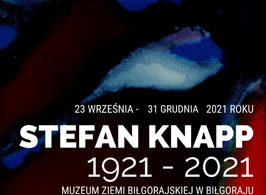
The Muzeum Bilgoraj celebrates the 100th anniversary of Stefan Knapp's birth (July 11, 1921 - November 12, 1996), a painter, enamelware and sculptor born and raised in Biłgoraj. The world-famous artist, who emigrated to Great Britain after World War II, often returned to his hometown. The exhibition was created in cooperation with Mid Wales Arts, based on the collections of the National Museum in Warsaw, the National Museum in Kielce, the Silesian Museum in Katowice, the KUL Museum and their own collection, as well as some of the works borrowed from private collections. The exhibition will present his paintings, souvenirs, catalogs, photographs and film materials about the artist.
Stefan Knapp was born and raised in Biłgoraj. While still a student of the Lviv Technical Secondary School, he was caught during a street round-up in Lviv in 1940. He was sent to prison in Kherson, successively to one of the labor camps in Siberia. Released under the Sikorski-Majski pact, he joined the Anders Army, with which he escaped to Great Britain, where he became an RAF pilot. After the war, he gained fame thanks to gigantic murals created for architectural adornment, such as at Heathrow in London, and the Seagram Building in New York. He believed that art should be gallery free, it should be accessible and create the background of our lives. He was fascinated by color, which was his main means of artistic expression - especially in his early works. Stefan Knapp was described as a symbolist, surrealist, conceptual artist or creator of abstract impressionism. His work was compared by John Russell to the play of Kandinsky. He was even referred to as the Prometheus of modern art - instead of fire, he was to steal color from the gods. He was called an artist, designer, craftsman and steel worker. Stefan Knapp wasn’t interested in any of these opinions or labels. He was beyond any framework.
Curator: Maja Toczona-Wal
